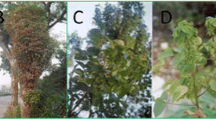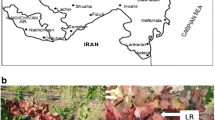Abstract
Sequence comparisons and phylogenetic analysis of the 16S rRNA genes and the 16S/23S spacer regions of the phytoplasmas associated with Australian grapevine yellows, papaya dieback and Phormium yellow leaf diseases revealed minimal nucleotide differences between them resulting in the formation of a monophyletic group. Therefore, along with Australian grapevine yellows, the phytoplasmas associated with Phormium yellow leaf and papaya dieback should also be considered as ‘Candidatus Phytoplasma australiense’.
Similar content being viewed by others
References
Andersen MT, Beever RE, Gilman AC, Liefting LW, Balmori E, Beck DL, Sutherland PW, Bryan GT, Gardner RC and Forster RLS (1998) Detection of phormium yellow leaf phytoplasma in New Zealand flax (Phormium tenax) using nested PCRs. Plant Pathol 47: 188-196
Boyce WR (1958) Resistance to yellow-leaf disease of Phormium tenaxForst. and the occurrence of delayed expression of symptoms. NZ J Agric Res 1: 31-36
Boyce WR and Newhook FJ (1953) Investigations into yellow-leaf disease of Phormium. I. History and symptomatology. NZ J Sci Technol 34A (Supplement 1): 1-11
Davis RE, Dally EL, Gundersen DE, Lee I-M and Habili N (1997) ‘CandidatusPhytoplasma australiense,’ a new phytoplasma taxon associated with Australian grapevine yellows. Int J Syst Bacteriol 47: 262-269
Devereux J, Haeberli P and Smithies O (1990) A comprehensive set of sequence analysis programs for the VAX. Nucleic Acids Res 12: 387-395
Felsenstein J (1985) Confidence limits on phylogenies: An approach using the bootstrap. Evolution 39: 783-791
Feng D-F and Doolittle RF (1987) Progressive sequence alignment as a prerequisite to correct phylogenetic trees. J Mol Evol 25: 351-360
Gibb KS, Persley DM, Schneider B and Thomas JE (1996) Phytoplasmas associated with papaya diseases in Australia. Plant Dis 80: 174-178
Gibb KS, Schneider B and Padovan AC (1998) Differential detection and genetic relatedness of phytoplasmas in papaya. Plant Pathol 47: 325-332
Glennie JD and Chapman KR (1976) A review of dieback-a disorder of the papaw (Carica papayaL.) in Queensland. Queensl J Agric Anim Sci 33: 177-188
Gundersen DE, Lee I-M, Rehner SA, Davis RE and Kingsbury DT (1994) Phylogeny of mycoplasmalike organisms (phytoplasmas): a basis for their classification. J Bacteriol 176: 5244-5254
Keohavong P and Thilly WG (1989) Fidelity of DNA polymerases in DNA amplification. Proc Natl Acad Sci USA 86: 9253-9257
Kirkpatrick B, Smart C, Gardner S, Gao J-L, Ahrens U, Maurer R, Schneider B, Lorenz K-H, Seemüller E, Harrison N, Namba S and Daire X (1994) Phylogenetic relationships of plant pathogenic MLOs established by 16/23S rDNA spacer sequences. IOM Lett 3: 228-229
Lee I-M, Hammond RW, Davis RE and Gundersen DE (1993) Universal amplification and analysis of pathogen 16S rDNA for classification and identification of mycoplasmalike organisms. Phytopathology 83: 834-842
Liefting LW, Andersen MT, Beever RE, Gardner RC and Forster RLS (1996) Sequence heterogeneity in the two 16S rRNA genes of Phormiumyellow leaf phytoplasma. Appl Environ Microbiol 62: 3133-3139
Liu B, White DT, Walsh KB and Scott PT (1996) Detection of phytoplasmas in dieback, yellow crinkle, and mosaic diseases of papaya using polymerase chain reaction techniques. Aust J Agric Res 47: 387-394
Magarey PA, Plavsic B and Wachtel MF (1988) MLO associated with Australian grapevine yellows diseased phloem cells. Int J Trop Plant Dis 6: 175-179
Murray RGE and Schleifer KH (1994) Taxonomic notes: A proposal for recording the properties of putative taxa of procaryotes. Int J Syst Bacteriol 44: 174-176
Padovan AC, Gibb KS, Bertaccini A, Vibio M, Bonfiglioli RE, Magarey PA and Sears BB (1995) Molecular detection of the Australian grapevine yellows phytoplasma and comparison with grapevine yellows phytoplasmas from Italy. Aust J Grape Wine Res 1: 25-31
Padovan AC, Gibb KS, Daire X and Boudon-Padieu E (1996) A comparison of the phytoplasma associated with Australian grapevine yellows to other phytoplasmas in grapevine. Vitis 35: 189-194
Saiki RK, Gelfand DH, Stoffel S, Scharf SJ, Higuchi R, Horn GT, Mullis KB and Erlich HA (1988) Primer-directed enzymatic amplification of DNA with a thermostable DNA polymerase. Science 239: 487-491
Schneider B, Ahrens U, Kirkpatrick BC and Seemüller E (1993) Classification of plant-pathogenic mycoplasma-like organisms using restriction-site analysis of PCR-amplified 16S rDNA. J Gen Microbiol 139: 519-527
Schneider B, Gibb KS and Seemüller E (1997) Sequence and RFLP analysis of the elongation factor Tu gene used in differentiation and classification of phytoplasmas. Microbiology 143: 3381-3389
Schneider B and Seemüller E (1994) Presence of two sets of ribosomal genes in phytopathogenic mollicutes. Appl Environ Microbiol 60: 3409-3412
Seemüller E, Schneider B, Mäurer R, Ahrens U, Daire X, Kison H, Lorenz K-H, Firrao G, Avinent L, Sears BB and Stackebrandt E (1994) Phylogenetic classification of phytopathogenic mollicutes by sequence analysis of 16S ribosomal DNA. Int J Syst Bacteriol 44: 440-446
Swofford DL (1990) PAUP: phylogenetic analysis using parsimony, version 3.0. Complete program and manual. Illinois Natural History Survey, Champaign
Tully JG (1995) International Committee on Systematic Bacteriology Subcommittee on the Taxonomy of Mollicutes. Minutes of the interim meeting, July 1994, Bordeaux, France. Int J Syst Bacteriol 45: 415-417
Ushiyama R, Bullivant S and Matthews REF (1969) A mycoplasmalike organism associated with Phormium yellow leaf disease. NZ J Bot 7: 363-371
White DT, Billington SJ, Walsh KB and Scott PT (1997) DNA sequence analysis supports the association of phytoplasmas with papaya (Carica papaya) dieback, yellow crinkle and mosaic. Australas Plant Pathol 26: 28-36
Author information
Authors and Affiliations
Rights and permissions
About this article
Cite this article
Liefting, L.W., Padovan, A.C., Gibb, K.S. et al. ‘Candidatus Phytoplasma australiense’ is the phytoplasma associated with Australian grapevine yellows, papaya dieback and Phormium yellow leaf diseases. European Journal of Plant Pathology 104, 619–623 (1998). https://doi.org/10.1023/A:1008693904427
Issue Date:
DOI: https://doi.org/10.1023/A:1008693904427




